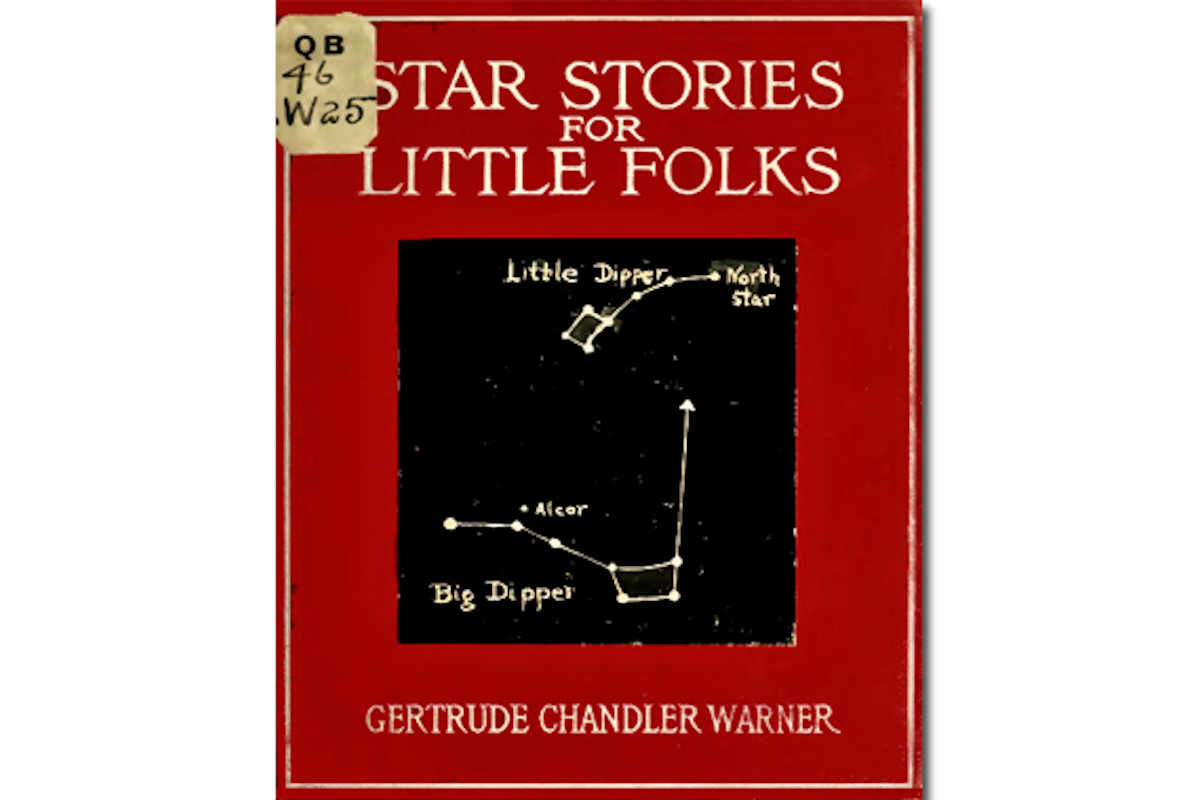
We originally posted Star Stories for Little Folks by Gertrude Chandler Warner back in August 2013, but have updated and expanded our original post to include more go-alongs and a more descriptive title. You’ll also find a link to our free star pages below. Enjoy!
Astronomy is one of the “oldest and least-known of all Nature-Studies” according to Gertrude Chandler Warner, author of the well-loved Boxcar Children books. To remedy this, in 1918 she wrote Star Stories for Little Folks, a beautiful and creative living book about the stars and planets.
The story is told from the perspective of a little girl named Helen who is being tutored in the stars by Dr. Lorry. The book covers the two dippers, Orion, and other major constellations, along with the planets Mars, Jupiter, Venus, and Saturn.
A short chapter is devoted to each constellation and in story form explains when to find the constellation, how to find the constellation, and the stars that make up the constellation. There are also asides discussing magnitude, star color, the Milky Way, meteor showers, and other interesting facts.
The chapters are arranged chronologically by the month in which you are most likely to see the constellations beginning with November and continuing through October of the following year. It is easy to just pick up in the month you are starting the book.
Interestingly, this book can also be made into a star notebook! Opposing pages show the constellations with the stars and lines in white against a black background along with a space below to record when the constellation was spotted. In the second chapter, Helen uses these black pages to make a small blue book she calls “MY STAR BOOK.”
“That’s a fine idea!” exclaimed the doctor. “I wish every little girl in the United States had one….”
Written directly to young people, phonetic pronunciation guides are provided for the longer words. The mythology typically included in such a book is also absent. A “DIPLOMA” at the end of the book signifies completion and that the reader
has learned fifteen constellations and four planets and is fully qualified to enjoy the oldest and least known of all Nature-Studies.
Free eBook:
Suggestions
- Create your own STAR BOOK by printing out the black star cards, gluing them to white card stock, and binding or stapling them together. Don’t forget to include an interesting cover! (Free star pages link printables below for those interested.)
- Create a chart showing the name of each constellation or planet and when it is easiest to find in the sky. This will be a great reference and can be placed in the front of your star book.
- Take the star cards outside at night or into a darkened room and shine a small flashlight on the card. Do you see how the white stars stand out, making the card an easy reference? You’ll want to have your star book with you when you search the sky for constellations!
- Learn more about star magnitude. (Chapter II)
- Find out what makes the stars appear to be different colors. (Chapter III)
- Find references to the Pleiades in the Bible as mentioned in Chapter III.
- The references mentioned above are found in Chapter IV. You might copy these verses under the appropriate stars in your star book.
- Study the Milky Way. (Chapter V).
- The Leonids are “magnificent” every thirty-three years. Considering Dr. Lorry and Helen were going to watch them in 1932, when will the next “big show” occur? (Chapter VII)
- Where is Arcturus mentioned in the Bible? (Chapter VII)
- Study meteors. (Chapter X)
- “When you think you are forgetting these constellations just try to teach them to somebody else.” Great advice! Narrate what you have learned so far to someone else. (Chapter XV)
- How can you tell a planet from a star? Add a page to your star book and copy what you need to know about planets. (Chapter XVI)
Additional Resources
What are Constellations?
Answers at NASA.
Stellar Brightness
Magnitudes for the 27 brightest stars along with information on the magnitude scale.
Star Colors Explained
What colors they are and why.
Our System’s Location in the Milky Way Galaxy
Simple facts from Enchanted Learning.
Constellation Map
For viewing or printing.
Activities
Planetarium for Your Computer {Free}
Open source software to help you locate the various constellations in your part of the world.
Interactive Sky Chart
Fun interactive from Sky & Telescope that helps students find the constellations in the sky.
Stargazer
Make an indoor stargazer!
Unit Studies & Lesson Plans

Free Nature Studies: The Solar System
Part of our free nature studies that covers stars, planets, and other sky features.
What are Stars?
Free lesson from Great Science Adventures: The World of Space by Dinah Zike that includes foldables, two activities and enrichment activities. Helpful for studying meteors.
Notebooking Pages / Printables
Star Pages ~ Free
We’ve put together these free primary- and regular-lined star pages to create a Star Book.










You must be logged in to post a comment.